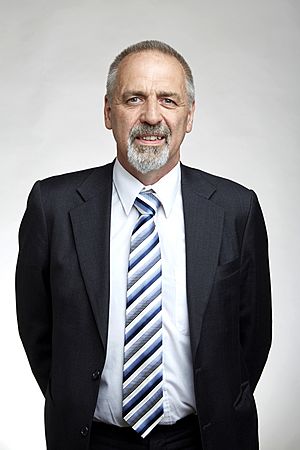John Speakman facts for kids
Quick facts for kids
John Speakman
|
|
|---|---|

Speakman in 2018
|
|
| Born |
John Roger Speakman
November 1958 (age 66) |
| Nationality | British |
| Education | Leigh Grammar School |
| Alma mater | University of Stirling |
| Spouse(s) | Mary Speakman |
| Awards | Royal Society Wolfson Research Merit Award (2016) |
| Scientific career | |
| Fields | |
| Institutions | University of Aberdeen Chinese Academy of Sciences |
| Thesis | The energetics of foraging in wading birds (Charadrii) (1984) |
| Doctoral advisor | David Bryant |
John Roger Speakman (born in 1958) is a British biologist. He works at the University of Aberdeen in Scotland. From 2007 to 2011, he was the Director of the Institute of Biological and Environmental Sciences there.
Professor Speakman leads a research group that studies how animals use and balance their energy. They use a special method called doubly labeled water (DLW). From 2011 to 2020, he also worked in China at the Chinese Academy of Sciences. He now works at the Shenzhen Institutes of Advanced Technology in China, leading research on metabolism and health.
Contents
Schooling and Degrees
John Speakman went to Leigh Grammar School near Manchester. He then studied at the University of Stirling. In 1980, he earned a Bachelor of Science (BSc) degree in Biology and Psychology.
In 1984, he completed his PhD. His research was about how wading birds use energy when they look for food. Later, he earned two higher degrees called Doctor of Science (DSc). One was from the University of Aberdeen in 1996, and the other from the University of Stirling in 2009. In 2017, he also earned a BSc in Maths and Statistics from the Open University.
Research and Discoveries
Professor Speakman's work focuses on how animals and humans use energy. He studies why some animals use more or less energy. He also looks at what causes obesity and how energy use affects aging.
He is a top expert in using special isotope methods to measure energy. He has used these methods on many different animals, from wild species to humans.
Understanding Energy Use
In the 1980s and 1990s, Speakman helped develop the "doubly labeled water" (DLW) method. This method helps scientists measure how much energy living things use. In 1997, he published a book about it.
Since 2018, he has led a group that manages a huge database. This database has over 7,500 measurements of human energy use from the DLW method. In 2021, a big study using this data was published. It showed how human metabolism changes from babies to older adults.
Research on Obesity
Speakman has also done important work on obesity. He questions an old idea called the "thrifty gene hypothesis." This idea suggests that humans developed "thrifty" genes to store fat during times of famine.
Speakman's own idea is called the "drifty gene hypothesis." He thinks that obesity became more common because humans faced less danger from predation. This meant that genes related to storing fat were no longer a disadvantage. This idea is still debated by other scientists.
His group also found a link between a gene called FTO and how much food humans eat. This was the first time such a link was found.
The Heat Dissipation Limit Idea
With his colleague Ela Krol, Speakman developed a new idea about energy use in animals. It's called the "heat dissipation limit hypothesis" (HDL). This idea suggests that animals' energy use is limited by how well they can get rid of body heat.
This idea has big implications for understanding animals. For example, it could explain why animals live in certain areas. It might also explain the maximum size of warm-blooded animals, like dinosaurs. This idea changes how scientists think about what controls energy use in animals. It suggests the limit comes from inside the animal, not just from outside factors like food.
Sharing Science
Professor Speakman writes a popular science column for a magazine called 'Newton'. He has also published three books that collect these articles.
He also co-wrote a textbook called Animal Physiology in 2020. You can find his scientific papers on websites like Google Scholar.
Awards and Recognitions
John Speakman has received many awards and honors for his scientific work. Here are some of them:
- 1991: Elected Fellow of the Royal Society of Biology (FRSB).
- 1995: Received a scientific medal from the Zoological Society of London.
- 2004: Elected Fellow of the Royal Society of Edinburgh (FRSE).
- 2008: Elected Fellow of the UK Academy of Medical Sciences (FMedSci).
- 2011: Awarded a "1000 talents" professorship in China.
- 2015: Became the first Briton to receive the Chinese Academy of Sciences medal for International Cooperation.
- 2016: Received the Royal Society Wolfson Research Merit Award.
- 2018: Elected a Fellow of the Royal Society (FRS), which is a very high honor in science.
- 2020: Elected a foreign member of the US National Academy of Sciences. He is one of only 28 scientists in the world to be a fellow of the UK, US, and Chinese National academies at the same time.
- 2021: Received the Chinese Friendship Award, the highest honor given by the Chinese government to foreign nationals.
- 2023: Awarded the Dale Medal, the highest honor from the UK Society for Endocrinology.
- 2024: Received the Solomon Berson Medal, the highest award from the American Physiology Society's endocrinology and metabolism section.


